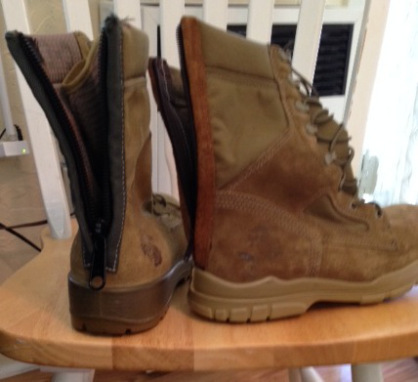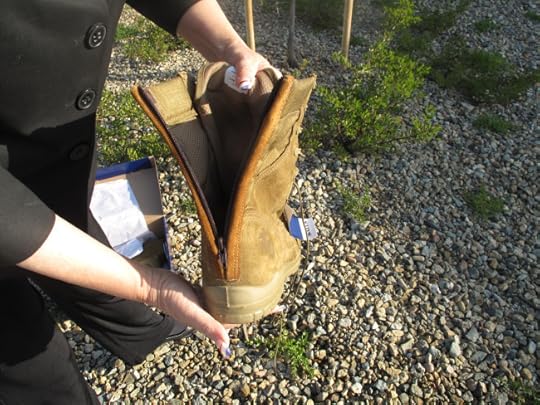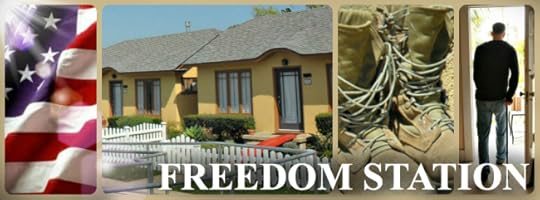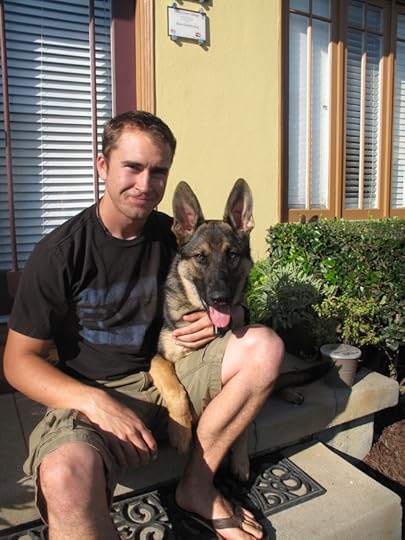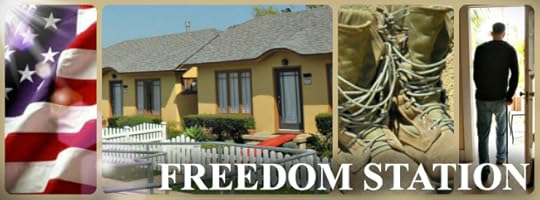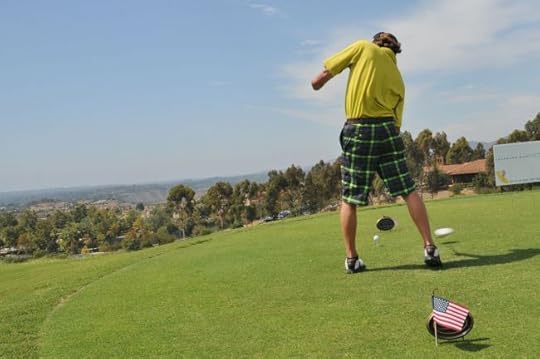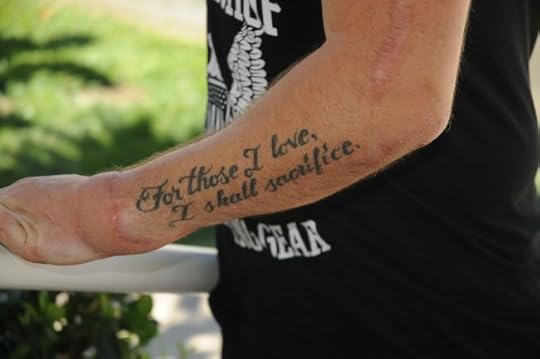R.J. Belle's Blog, page 5
May 25, 2014
These Boots Are Made for Heroes
Put yourself right here – here in this place I am about to take you to and tell me what things would matter the most to you…
You are on a routine patrol one day in the desert and upon entry into an abandoned building you take one step onto an explosive. An explosive placed there with the sole purpose of killing someone but, that day your number isn’t up and you don’t die. There is a whole story in between that step you took – the one that changed your life forever – and where you are today but, we will save that part of the story for another time.
So here you are, rehabbed, fitted with a state of the art prosthetic leg and begging to be sent back into the fight. Yes, begging. Begging to be the same Marine you were before that day that your leg was taken from you. Begging to be placed back into battle with your brothers, placed back into the very place that took so much from you. You just want to go back to normal back to who and what you were before that day. A Marine. Period. Pride comes into play here – c’mon, you know it does – a ton of pride. The kind of pride that few understand let alone display. Quick – tell me as you are packing up your bag – what are the top items you absolutely have to take with you? Think really hard here. You have a prosthetic leg and you are going back out to the desert, back out to your unit and back among your brothers. I am going to leave a wide-open space here. Please don’t read ahead. I want you to close your eyes and imagine packing that bag. What do you need? What do you need to feel like you will fit back in? Now just sit with that list in your mind and continue on.
You made it back to your unit. OOHRAH! You are either back in the fight or starting another fight as you work on your rehabilitation process. So when your first muster comes and you are standing in a line among your brothers, and ecstatic just to be back; you look down and what do you see? What do you imagine all of your brothers see? Two boots on the ground? Guess again. When you look down at your feet you see one standard issue boot and one athletic shoe. The reason is simple – a Marine issue boot will not fit on your prosthetic. Now, I know what you’re thinking. Why wouldn’t I be issued a boot that fit on my prosthetic? Why would I be made to look different from my brothers lined up next to me? Why should I have undue and unwanted attention drawn to my prosthetic? And…I don’t want to look different, I don’t want pity and I sure as hell don’t want anyone in my unit thinking that I can’t do the job of any other capable Marine. They need to know I have their backs. But standing there in your one boot, one athletic shoe ensemble – well, you don’t feel like that. You do feel different and it’s a problem. So, what do you do now? You call Warrior Foundation~Freedom Station. And that is exactly what happened and how the story of the boots started. Sandy Lehmkuhler, the director at Warrior Foundation~Freedom Station, recounts the beginning of the story of the boots and hearing her tell the story is far more fascinating than my attempt at it will be but, I will do my best.
In 2006, Sandy was listening in as a conversation was taking place between a few Marines in a room at Balboa Naval Hospital in San Diego, Ca. One of the warriors involved in that conversation was talking about the strong desire to be a “well-groomed Marine” and be appropriately dressed. As she was standing there watching a Marine try to get a standard issue boot on his prosthetic and listening to the conversation unfold, she had an idea – a brilliant idea.
Sandy took a standard issue Marine boot to a local shoe cobbler to see if he could come up with a way to insert a zipper into the back of the boot making it able to fit onto a prosthetic. This amazing man did just that and the first modified boot was born. The problem, as discovered by the Marines using the new boot, was that it was too heavy to comfortably swing with a prosthetic leg and the zipper was easily made non-operational when introduced to use in sand. The product design process went back and forth several times before the current boot design was perfected. After trial and error and tireless design re-working by both Sandy and the shoe cobbler – they have come up with a workable design that utilizes a Marine issue Ultra-Light boot outfitted with a special zipper design and an oil to keep the zipper lubricated and free from debris distraction. There is currently a patent pending on this design and Sandy hopes to be able to provide these boots to any Marine amputee who requests them.
Since 2007, Freedom Station has sent over thirty-five hundred boots to Marines – those deployed as well as those on active duty status going through the rehabilitation process. Sandy purchases the Ultra-Light boots from a local military base at a cost of $140 a pair in the size needed by the requestor. Then she takes the boots to the shoe cobbler who inserts the zipper design – virtually free of charge – and finally Sandy sends the final product to the Marine who requested them.
This may not seem like a huge deal to you but, if you really think about what a modified, useable and properly fitting boot means to a Marine who wants to serve, fit in and stand up on two boots I believe you will agree that this is not only a meaningful project but a necessary one. And although you may not be able to make a giant difference to many – you can make a significant difference to a Marine by simply donating the cost of a pair of boots to Warrior Foundation~Freedom Station.
There is no more meaningful way to say THANK YOU to one of our Warrior’s than by assisting an organization that does everything possible, including designing boots, to make their recovery, rehabilitation and transition easier.
-RJ
Warrior Foundation~Freedom Station is a nonprofilt 501(c)3 status organization dedicated to assisting military men and women who have served our country in the War Against Terrorism. 100% of funds raised go towards assisting the Warriors – all volunteer’s work without salary or payment of any kind.
To donate any amount or set up a monthly donation to Warrior Foundation~Freedom Station please click on the link below.
http://www.warriorfoundation.org/donation
To learn more about Warrior Foundation~Freedom Station click here: http://www.warriorfoundation.org


May 7, 2014
Who Will Help the Heroes?
Today I had the honor of spending time at Warrior Foundation~Freedom Station in San Diego, CA, and what they do is extraordinary. It should be the norm; we should all welcome home, help and support our injured military heroes — but we don’t. We have freedom because there are men and women who freely make sacrifices to assure that we do. Freedom is taken for granted by so many of us and it saddens me to know that this is the case. It saddens me because by taking our freedom for granted, we blatantly disrespect those who have made sacrifices on our behalf, as well as those who have paid the ultimate price.
The men and women who serve — past and present — well, most of them that I have ever met and spoken with shrug the disrespect off. They almost unanimously say they chose to serve for personal reasons and not solely for the altruistic reason of protecting our freedoms. But for whatever reason these men and women chose to join the military, by doing so whether intentional or not, they do assure our freedoms.
When I talk of sacrifice you might think I mean only the loss of life or a limb. And certainly those are high prices to pay. However, there are many other sacrifices that our service members and their families make. They earn a wage that is laughable at best; endure separation from spouses, children, parents, siblings and friends. They relocate on command, for most — every four years. They deploy to countries that have little or none of the comforts that we enjoy everyday here in the USA. And yes, they put their lives in danger. Imagine if you will for just one moment, waking up every day and putting your boots on to go to work but, your office building is a desert floor and you face off against employees from a competitor’s company who instead of trying to steal trade secrets or a client — they want to kill you.
None of the above is new news, right? We have all read about it, heard about it and many are to the point where they have tuned out. Guess what? While we are tuning out and moving on with our safe little lives here in sunny San Diego; there is an entire population among us trying to do the same thing. They are trying to move on too. For them, the men and women who returned from a war that changed their lives in more ways than can be seen with the human eye, that transition goes far beyond switching the television channel from CNN to American Idol.
For returning, injured service members, the biggest war of their lives lies ahead. That war will be fought learning how to integrate back into a society that has tuned them out. It will be in learning how to perform basic tasks like tying a shoe, fixing themselves a meal, brushing their own hair and teeth, and strapping on a prosthetic. They will fight to get a good night’s sleep when nightmares threaten to rob even that from them. They will try to fit back in, find a job, and answer that turned head many of us have, with a pride that can’t be taken away like a limb can be.
I have always had a soft heart for homeless veterans. I am fascinated by their stories and heartbroken by the fact that they, for whatever reason, do not have a child or grandchild to share their stories with. I have been in awe many times at the humble nature of many homeless veterans I have met over the years. So when I began the second book in the Paul Sutton Novel series, I was working on character creation and plot building when an idea came to me. What if I could do what I love (write) and help heroes in need? The character I was creating at the time was a homeless vet and I thought what better organization to donate a portion of novel proceeds to than an organization that assisted veterans. And so it began.
There has been a ton of interest in the Paul Sutton series so far and I predict that book two will start off strong. So I felt that donating a portion of the proceeds could end up being a substantial donation. I made the decision and set out to find the perfect organization and through a friend, I was introduced to Warrior Foundation~Freedom Station. I fully expected that setting off on this path would feel good but had no idea how profoundly I would be affected by my experience at Freedom Station today.
My first meeting with the director of Freedom Station, Sandy Lehmkuhler, was awesome and it became instantly apparent why Freedom Station makes such a huge impact. Sandy is amazing. AMAZING. I cannot state that strong enough and I could write a whole book on her alone. But if you know Sandy, you know that she neither seeks nor accepts one second in the limelight. She wants any and all attention focused solely on the men that Freedom Station serves — and rightfully so. Sandy is not alone in her efforts, she has an entire board of men and women who give back, pitch in and make Freedom Station the phenomenal place that it is. I had the opportunity to meet Judy Sexton and Katherine Ziezer today as well, two more amazing women making an incredible difference
When I first entered the office at Freedom Station, I was immediately drawn to a mantle full of photos of the heroes that Freedom Station serves. As Sandy began telling me stories about the men whose faces were displayed in the picture frames, she would pull a photo from the mantle and place it carefully into my hands and as I held each photo while listening to a story that I couldn’t possibly understand fully, it struck me that this is exactly where I was supposed to be. I listened and watched in awe as Sandy went from one story to the next, tears sometimes filling her kind eyes; her love for these men and passion for what she does was obvious. Sandy too was called to duty. She serves faithfully, alongside her team, assisting those men who might otherwise be tossed back out into the civilian population and become lost among the hundreds of thousands of other veterans trying to grab onto anything that feels like normalcy; oftentimes only to be swallowed up by a pain they cannot heal from alone, and thrown into a society that cannot begin to understand the personal war they now fight. They become lost and we continue to turn our heads and backs as they disappear into the darkness of the streets trying to forget a war that we don’t even acknowledge anymore. But for the men at Freedom Station, there is hope. They are seen, heard, cared for, mentored and loved. From basic needs to a place to call home while they re-tool and prepare to live productive civilian lives. They are given a chance — a chance to thrive, and a chance at skirting becoming yet another statistic.
Freedom Station offers more than a place to sleep –- much, much more. I will be doing blog posts on specific stories once a week for the month of May, which is Military Appreciation Month. My blog post next week will be a story about boots and it’s a story worth telling; it’s a story worth coming back to read.
I was going to wait until late June to announce this news. After the day I had today, I have decided to announce it early. Ten percent of the proceeds from the second book in the Paul Sutton Novel series, SECOND SIGHT, will go directly to Warrior Foundation~Freedom Station. I am also starting another project, a non-fiction book about Freedom Station, its board members and individual stories of the heroes that Freedom Station serves. We hope to have that project published in the fourth quarter of 2014 and one hundred percent of the proceeds from that project will go directly to Warrior Foundation~Freedom Station. So stay tuned and in the meantime read more about Freedom Station below and please take a moment to visit their website.
-R.J.
Freedom Station USA:
Helping Injured Warriors Transition from Military Service to Civilian Life
By Sandy Moul
A train station is where people go to begin a journey, or change course toward a new destination. That was the idea behind Freedom Station USA, a years-long labor of love by Navy wife Sandy Lehmkuhler. While volunteering at Naval Medical Center San Diego in 2004, Ms. Lehmkuhler was distraught to find that the hospital’s injured were in need of some basic quality-of-life items. Spurred by a conversation with two amputees who required special electric razors for shaving, she went on the radio to make a plea for donations and the Warrior Foundation was born. In partnership with the San Diego Council of the U.S. Navy League and under the guidance of its president at the time, retired Navy Commander Jim Bedinger, the Warrior Foundation gained its status as a 501(c)3 nonprofit and has since been dedicated to assisting military men and women who have served for our country in the War Against Terrorism. The foundation provides every kind of support imaginable, from airfare and hotel rooms for parents coming to their injured children’s bedsides, special sunglasses for those whose retinas detached after IED blasts, modified combat boots for prosthetic limbs, and hundreds of plane tickets to send warriors home every year for Christmas.
The day you find out you can no longer be in the military is a hard day.
In her work with the Warrior Foundation, Ms. Lehmkuhler realized there was a specific group of warriors who needed assistance in one crucial area – the transition from military to civilian life. The day that a Marine, soldier or sailor is told he can no longer be in the military as a result of his or her injuries is a very hard day. This particular group of warriors often enter a period fraught with fear, uncertainty and self-doubt as they await their medical retirement. They told Ms. Lehmkuhler what they needed was a supportive environment to assist with the transition to civilian life. It is during this critical transition that veterans may fall through the cracks and are at risk of homelessness or joblessness, as evidenced by Vietnam-era veterans who still constitute one of America’s largest homeless populations.
The veteran situation is unique in San Diego, one of the largest military industrial complexes in the world. According to a report by the National University System Institute for Policy Research, on any given night, between 1,700 to 2,000 veterans in San Diego sleep in temporary shelters or unsheltered conditions. According to the same report, over any 12-month period, approximately 3,700 veterans in San Diego experience at least one night of homelessness. The economic conditions facing younger veterans are especially difficult, increasing the risk that some will experience prolonged periods of homelessness.
The “missing link.”
While they may not be in a war zone anymore, injured servicemen and women face new challenges when they return home – the often untold story of coping with injuries, rehabilitation and a transition to civilian life. Ms. Lehmkuhler was determined to ensure that the men and women who risked their lives for our country would not fall on hard times once they could no longer serve. She and a group of highly dedicated volunteers made it their passion project to deliver what our military members were asking for – a recovery transition center called Freedom Station. This home for heroes would serve as the “missing link” and proactively combat veteran homelessness and joblessness, instead of react to it once it was too late. With this vision in mind, Freedom Station celebrated its grand opening in May 2011.
Freedom Station fills the void in San Diego for a transitional environment that servicemen and women often lack as they return to life outside of the military. Troops who have been injured in combat can return home with post-traumatic stress disorder, spinal cord injuries, amputations, traumatic brain injuries, burns and blindness. They find themselves not only coping with injuries, but facing medical retirement and an uncertain new life outside of the Armed Forces. Freedom Station creates a transitional period for acclimating to civilian life and also serves as a “training ground” for challenges ranging from new careers and college entry to monthly budgeting and home buying.
The capital was raised to lease and open the Freedom Station 12-unit housing complex over the course of several years. The property was selected partly for its location just minutes away from Naval Medical Center San Diego, which would make it easier for warriors to receive the medical treatment that is so important to their physical and emotional recovery.
The housing complex’s design was an equally significant factor. With four apartments and eight cottages all surrounding a central courtyard, Freedom Station was ideally set up to offer the camaraderie that is so crucial to veterans during the transition period. They are able to feel a true sense of community as they recover among their peers, share war stories and know they are supported by others who understand firsthand the harsh realities of war. Prior to opening the facility, Freedom Station invested a significant amount of capital into making necessary modifications, such as installing wheelchair-accessible ramps and converting several of the apartments to be ADA-compliant. Additionally, each unit was fully furnished and move-in ready, stocked with everything from cleaning supplies to place settings on each dining table. The idea was to shift the warriors from a “barracks mentality” to independent living by including the kinds of household items they would require in daily life.
In addition to providing a home, Freedom Station realized that during this critical time, warriors would also face many decisions that would affect the rest of their lives. They needed help pursuing a career, choosing and enrolling in a college or vocational school, learning how to manage their finances, and locating or purchasing independent housing. Freedom Station provides assistance with, and access to, professionals and qualified volunteers who assist with educational and career guidance, and other issues relevant to transitioning to civilian life. These services are provided to residents because a helping hand at this point – between the military and the seemingly awesome task of returning to civilian life – is the best way to help solve some of the issues cause by wartime.
The importance of timing the transition and being a hand up, not a hand out.
While other military housing and transitional facilities exist in the country, there are two key ways in which Freedom Station differs, which have ultimately led to its success. As such, the organization hopes to serve as a national model for similar developments.
The first differentiator is that most military housing facilities are designed to work with service members after they have already been retired or discharged from the military. In many cases, these veterans may already be having trouble and experiencing “fish out of water” syndrome. Freedom Station understands that the transition needs to take place before a military member leaves the service, giving them the necessary time to acclimate. When a warrior finds out he’s no longer going to be able to be in the military, for the most part, it takes about a year longer to be discharged. Instead of allowing them to continue living in the barracks as if active-duty military, Freedom Station saw the value in providing a comforting and supportive environment that would prepare warriors for life outside the military. To not do so in the manner that Freedom Station has constructed would be very hard and stressful on service members; therefore, an average 11-month timeframe for residency is provided. The organization is also unique in that it works directly with Naval Medical Center San Diego, and other local military medical facilities, whose staff and medical personnel are uniquely qualified to identify those most in need of a transitional home.
Secondly, Freedom Station is a hand up, not a hand out. The environment prepares residents for real-world civilian challenges. One of the most vital is having monthly expenses and taking care of those responsibilities. In addition to paying rent, they have utilities to manage, groceries and more. Many military transitional housing facilities are free and do not charge their residents any rent – an unrealistic preparation for real-world living. Although Freedom Station pays the lease on the property every month, residents pay a small amount of rent and are taught how to save and begin to move on. We are in the process of trying to purchase the property with the help of some very supportive donors. The Doyle Foundation, Blue Angel Foundation, KFMB Radio and TV Stations, Mor Furniture, Turner Construction, and Ashford University-Bridgepoint Education.
Journey to a new life.
As evidenced by Freedom Station “graduates” and success stories, the existence of a supportive transitional environment for our military men and women can make all the difference as they begin a new journey outside the service. It is Freedom Station’s hope to eventually purchase the facility and open additional facilities in the San Diego area, continuing to meet the needs of our military heroes and ensuring their successful transition to self-sufficient, productive and contributing members of society.


May 6, 2014
“And by the way…
“And by the way, everything in life is writable about if you have the outgoing guts to do it, and the imagination to improvise. The worst enemy to creativity is self-doubt.”
― Sylvia Plath, The Unabridged Journals of Sylvia Plath



